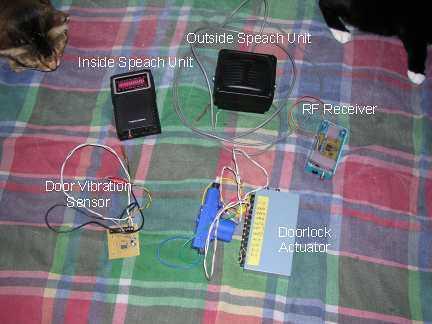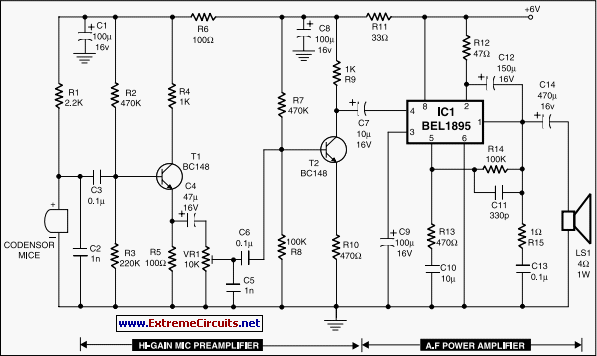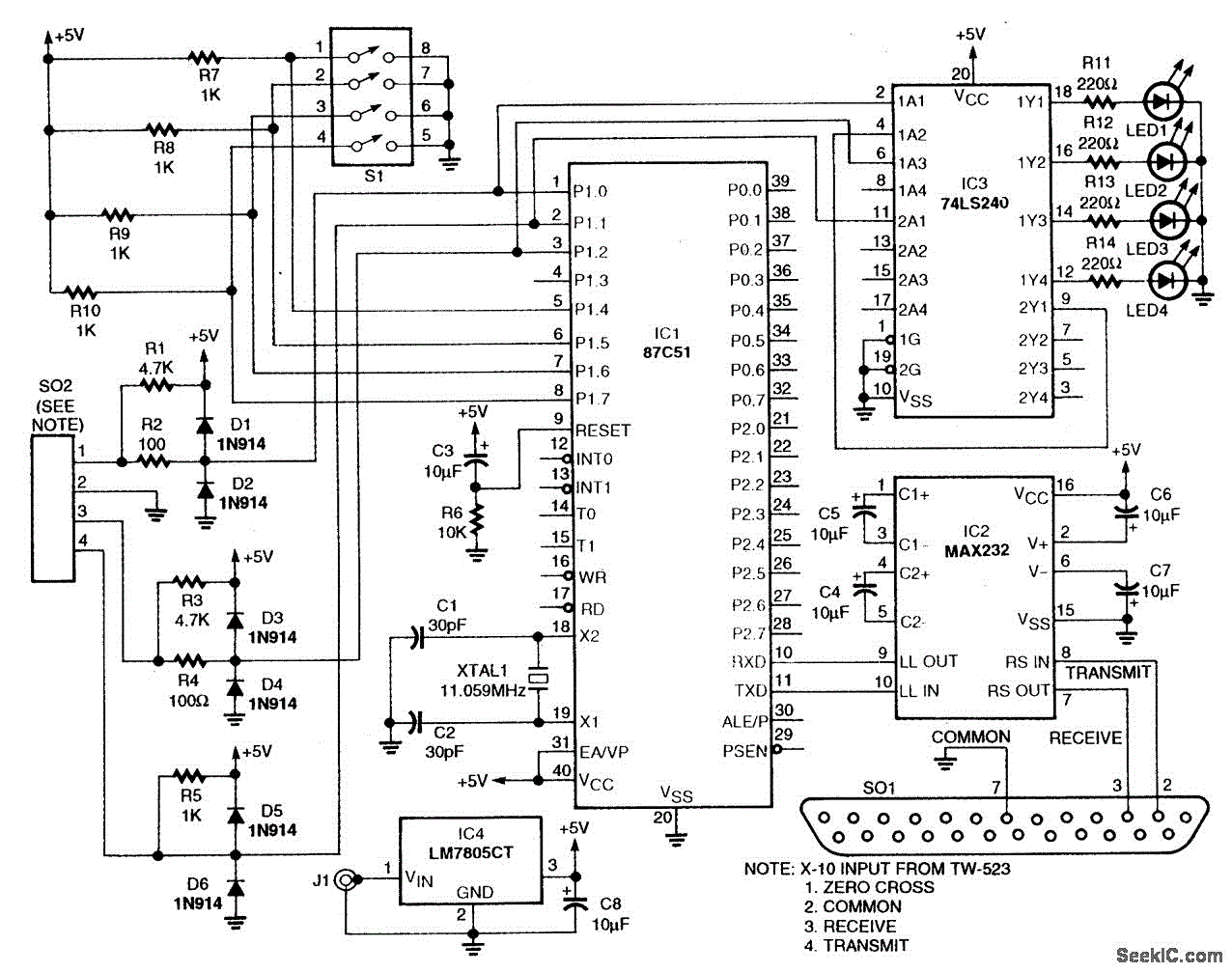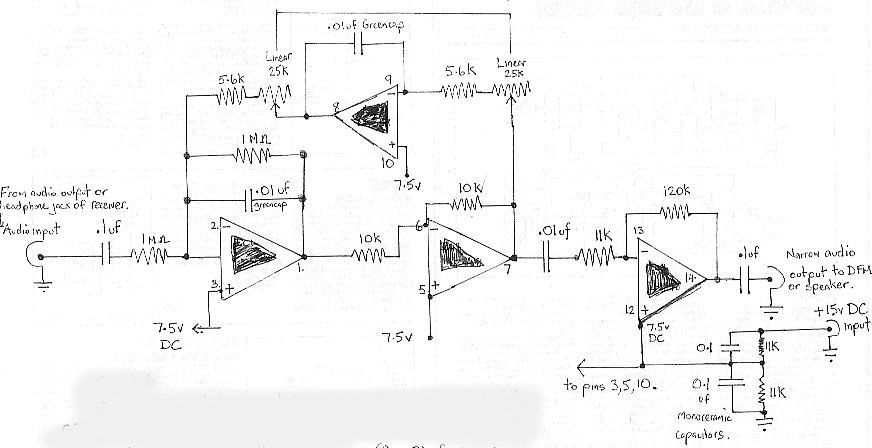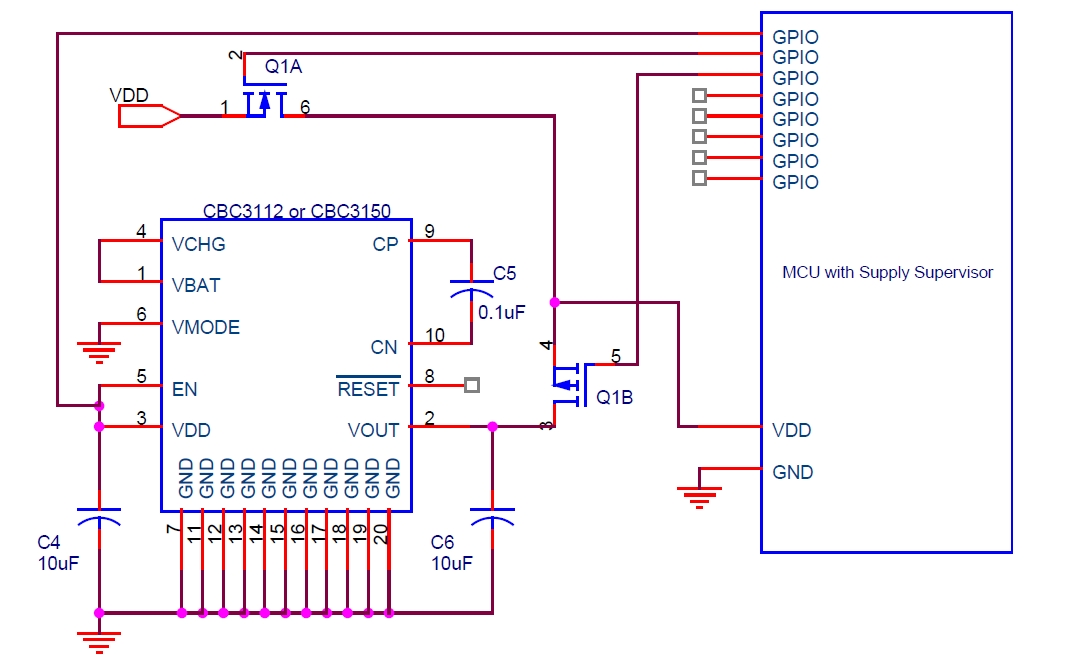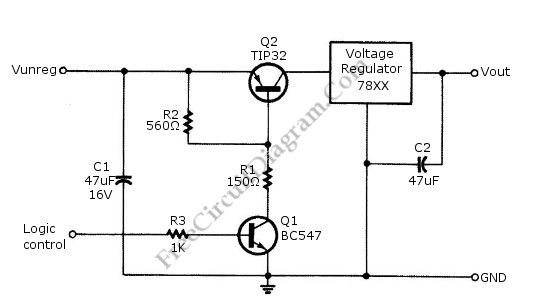
Headphone Audio Amplifier with Balance Control
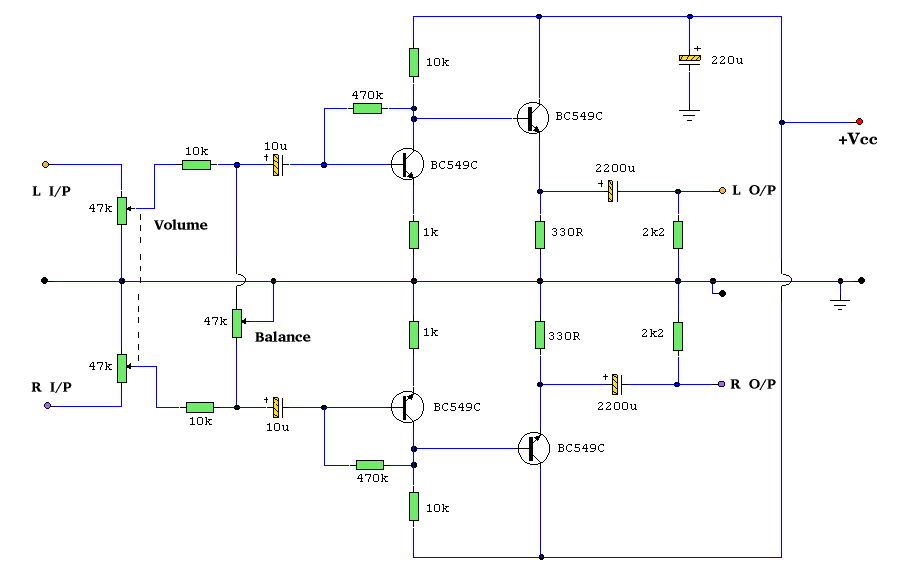
Both halves of the circuit are identical. Both inputs have a DC path to ground via the input 47k control, which should be a dual logarithmic type potentiometer. The balance control is a single 47k linear potentiometer, which, when adjusted to the middle position, ensures equal attenuation of both left and right input signals. If the balance control is shifted towards the left side, the left input track experiences less resistance compared to the right track, resulting in a greater reduction of the left channel relative to the right, and vice versa. The earlier 10k resistors ensure that neither input can be "shorted" to ground. Amplification of the audio signal is accomplished by a single-stage common emitter amplifier, followed by a direct-coupled emitter follower. The overall gain is less than 10, but the final emitter follower stage is capable of directly driving 8-ohm headphones. Higher impedance headphones will also function adequately. It is important to note the presence of a 2.2k resistor at each output, which eliminates the DC potential from the 2200μF coupling capacitors and prevents any audible "thump" when headphones are connected. The circuit is self-biasing and is designed to operate with any power supply ranging from 6 to 20 Volts DC.
This audio amplifier circuit features a symmetrical design, with both halves mirroring each other to ensure consistent performance across left and right channels. The inclusion of a dual logarithmic potentiometer for input control allows for precise adjustments, accommodating varying input levels. The balance control, implemented as a linear potentiometer, facilitates fine-tuning of signal levels between channels, enhancing the user experience by allowing for personalized audio balance.
The use of 10k resistors at the inputs serves a critical protective function, safeguarding against accidental short circuits to ground, which could otherwise damage the circuit or lead to malfunction. The common emitter amplifier stage is responsible for the initial amplification of the audio signal, characterized by a moderate gain that is sufficient for typical headphone applications. Following this, the emitter follower configuration provides a low-output impedance, enabling the circuit to drive headphones effectively.
The design accommodates 8-ohm headphones, which are common in consumer audio applications, while also supporting higher impedance headphones, making it versatile for various listening scenarios. The 2.2k output resistors play a vital role in maintaining signal integrity by blocking any DC offset that may arise from the coupling capacitors, thereby preventing disruptive sounds when headphones are connected or disconnected.
The self-biasing nature of the circuit simplifies its operation, allowing it to function across a wide range of DC power supply voltages, from 6 to 20 volts. This flexibility makes the circuit suitable for diverse applications, from portable audio devices to more stationary setups. Overall, the design emphasizes reliability, user control, and compatibility with standard audio equipment, making it an effective solution for audio amplification needs.Both halves of the circuit are identical. Both inputs have a dc path to ground via the input 47k control which ought to be a dual log type potentiometer. The balance control is a single 47k linear potentiometer, which at middle modification prevents even attenuation to both left and right input signals.
If the balance control is moved towards the left side, the left input track has less resistance than the right track and the left channel is reduced more than the right side and vice versa. The earlier 10k resitors be definite that neither input can be "shorted" to earth. Amplification of the audio signal is provided by a single stage common emitter amplifier and then via a direct coupled emitter follower.
Overall gain is less than 10 but the final emitter follower stage will directly drive 8 ohm headphones. Higher impedance headphones will work equally well. Note the final 2k2 resistor at each output. This removes the dc potential from the 2200u coupling capacitors and prevents any "thump" being heard when headphones are plugged in.
The circuit is self biasing and designed to work with any power supply from 6 to 20 Volts DC. 🔗 External reference
This audio amplifier circuit features a symmetrical design, with both halves mirroring each other to ensure consistent performance across left and right channels. The inclusion of a dual logarithmic potentiometer for input control allows for precise adjustments, accommodating varying input levels. The balance control, implemented as a linear potentiometer, facilitates fine-tuning of signal levels between channels, enhancing the user experience by allowing for personalized audio balance.
The use of 10k resistors at the inputs serves a critical protective function, safeguarding against accidental short circuits to ground, which could otherwise damage the circuit or lead to malfunction. The common emitter amplifier stage is responsible for the initial amplification of the audio signal, characterized by a moderate gain that is sufficient for typical headphone applications. Following this, the emitter follower configuration provides a low-output impedance, enabling the circuit to drive headphones effectively.
The design accommodates 8-ohm headphones, which are common in consumer audio applications, while also supporting higher impedance headphones, making it versatile for various listening scenarios. The 2.2k output resistors play a vital role in maintaining signal integrity by blocking any DC offset that may arise from the coupling capacitors, thereby preventing disruptive sounds when headphones are connected or disconnected.
The self-biasing nature of the circuit simplifies its operation, allowing it to function across a wide range of DC power supply voltages, from 6 to 20 volts. This flexibility makes the circuit suitable for diverse applications, from portable audio devices to more stationary setups. Overall, the design emphasizes reliability, user control, and compatibility with standard audio equipment, making it an effective solution for audio amplification needs.Both halves of the circuit are identical. Both inputs have a dc path to ground via the input 47k control which ought to be a dual log type potentiometer. The balance control is a single 47k linear potentiometer, which at middle modification prevents even attenuation to both left and right input signals.
If the balance control is moved towards the left side, the left input track has less resistance than the right track and the left channel is reduced more than the right side and vice versa. The earlier 10k resitors be definite that neither input can be "shorted" to earth. Amplification of the audio signal is provided by a single stage common emitter amplifier and then via a direct coupled emitter follower.
Overall gain is less than 10 but the final emitter follower stage will directly drive 8 ohm headphones. Higher impedance headphones will work equally well. Note the final 2k2 resistor at each output. This removes the dc potential from the 2200u coupling capacitors and prevents any "thump" being heard when headphones are plugged in.
The circuit is self biasing and designed to work with any power supply from 6 to 20 Volts DC. 🔗 External reference
Warning: include(partials/cookie-banner.php): Failed to open stream: Permission denied in /var/www/html/nextgr/view-circuit.php on line 713
Warning: include(): Failed opening 'partials/cookie-banner.php' for inclusion (include_path='.:/usr/share/php') in /var/www/html/nextgr/view-circuit.php on line 713
